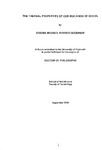The thermal properties of cob buildings of Devon
| dc.contributor.author | Goodhew, Steven Michael Rhyder | |
| dc.contributor.other | Faculty of Science and Engineering | en_US |
| dc.date.accessioned | 2011-09-22T12:00:25Z | |
| dc.date.available | 2011-09-22T12:00:25Z | |
| dc.date.issued | 2000 | |
| dc.identifier | Not available | en_US |
| dc.identifier.uri | http://hdl.handle.net/10026.1/594 | |
| dc.description.abstract |
Little has been published concerning the thermal properties of existing unbaked earth walls. In order to model the thermal behaviour of a building constructed using traditional cob walls, the thermal conductivity and thermal diffusivity need to be established. The Centre for Earthen Architecture (CEA), based at the University of Plymouth's School of Architecture has carried out research into various aspects of cob architecture typical to the Devon area. This study supplements other work concerning the moisture content, structure and pathology of cob as a building material. This research concentrates upon the development of a time dependent probe technique for the measurement of the thermal conductivity and thermal diffusivity of cob. The literature concerning the technique is reviewed. Methods of obtaining thermal data from the results are discussed. Particular emphasis is placed upon the measurement of the probe's thermal contact conductance with the test material. A series of laboratory tests and results from specific test materials are described. From this work, a link between the improvement of the thermal contact between the probe and the specimen and the accuracy of the thermal diffusivity values is established. The development of field test apparatus is described and the results from three field tests are examined. Values for thermal conductivity, diffusivity and the probe thermal contact conductance are established. These results are used in a thermal simulation of a cob dwelling. The output from the simulation is compared with results from a modern timberframe house of identical dimensions and use. The thermal response of the modern timber-frame house was found to be similar to that of the cob dwelling. However, generally, the range of internal air temperature was found to be higher in the interior spaces of the timber framed dwelling than the cob dwelling. | en_US |
| dc.language.iso | en | en_US |
| dc.publisher | University of Plymouth | en_US |
| dc.title | The thermal properties of cob buildings of Devon | en_US |
| dc.type | Thesis | |
| dc.identifier.doi | http://dx.doi.org/10.24382/3826 |
Files in this item
This item appears in the following Collection(s)
-
01 Research Theses Main Collection
Research Theses Main


